The current article is the continuation of the previous article (My E-mail appears as spam…
Commercial E-mail – Using the right tools | Office 365 | Part 4#17
The current article dedicated to the subject of – ”Commercial E-mail”. At first glance, there is no clear relationship between the subject of internal/outbound spam and commercial E-mail but my arguments are:
- Most of the time, the main reason for the phenomenon of internal/outbound spam is related to misuse of commercial E-mail. Lack of knowledge and awareness about the fact that in case that we use a commercial E-mail, we should plan and design our commercial E-mail and, pay attention too many “don’t do” rules etc.
- Office 365 and Exchange Online are not the optimal platforms for using and managing commercial E-mail.
Table of contents
What is commercial E-mail?
The “translation” of commercial E-mail could be – E-mail campaign, Marketing E-mail, Newsletters, large mailing lists, Bulk mail and so on.
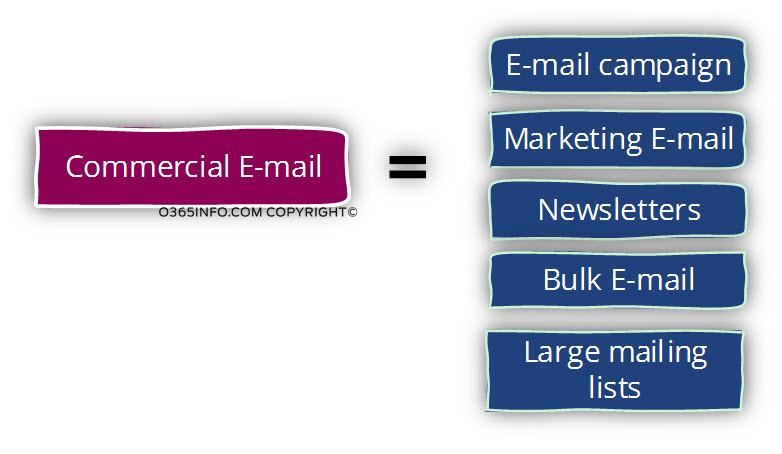
Because the definition of commercial mail is more on the “legal side”, I prefer to use quotation from the USA government FTC site:
Any electronic mail message the primary purpose of which is the commercial advertisement or promotion of a commercial product or service,” including email that promotes content on commercial websites. The law makes no exception for business-to-business email. That means all email – for example, a message to previous customers announcing a new product line – must comply with the law.
Besides the definition of commercial E-mail, the article relates to the “rules” and to the thing we should avoid when using commercial E-mail. The article includes a set of a guideline, that emphases the “do” and the “don’t” regarding the subject of commercial E-mail.
Here is a partial quotation from the USA government FTC site:
Don’t use false or misleading header information. Your “From,” “To,” “Reply-To,” and routing information – including the originating domain name and email address – must be accurate and identify the person or business who initiated the message.
Don’t use deceptive subject lines. The subject line must accurately reflect the content of the message.
Identify the message as an ad. The law gives you a lot of leeway in how doing this, but you must disclose clearly and conspicuously that your message is an advertisement.
Tell recipients where you’re located. Your message must include your valid physical postal address. This can be your current street address, a post office box you’ve registered with the U.S. Postal Service, or a private mailbox you’ve registered with a commercial mail receiving agency established under Postal Service regulations.
Commercial E-mail as part of the business process
Because commercial mail is a business need, we will need to “respect” this business need, allocate the require resource, implement the best practice and so on.
To be able to successfully using and managing commercial E-mail, we will need to use a dedicated platform or a product that will help us to manage all of the different aspects that relates to commercial E-mail.
There are many providers and platforms, which was created especially for providing a suitable solution for the specific needs of a commercial E-mail.
I’m not “pointing out” a particular provider but, my opinion is that Office 365 and Exchange Online was not created for as a “solution for commercial E-mail”.
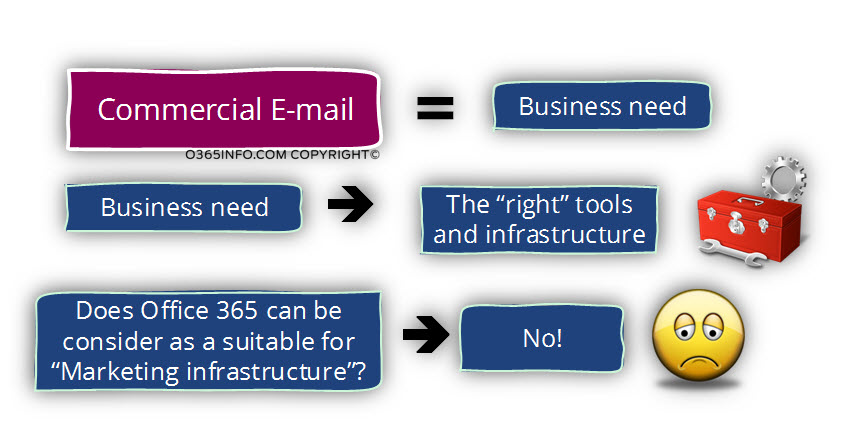
Why do I think that Office 365/Exchange Online is unsuitable for the purpose of commercial E-mail?
One of the most common miss conceptions among Office 365 customers is that – Office 365 and Exchange Online can use as a tool or infrastructure for commercial E-mail.
The source for this miss conception is that – commercial E-mail (as the name suggests) is implemented by using mail infrastructure and Exchange Online is mail infrastructure.
This assumption is correct, but the main issue is that commercial E-mail needs a very specific mail infrastructure and additional components that are not included in a “standard mail infrastructure” such as Exchange Online in our scenario.
Office 365 and Exchange Online was not created for fulfilling the business requirements for a commercial E-mail.
The next quotes, are from a Microsoft article which displays the Exchange Online boundaries:
Exchange Online customers who need to send legitimate bulk commercial email (for example, customer newsletters) should use third-party providers that specialize in these services.
Using FOPE or EOP to send bulk email is not a recommended or supported use of the service. It is permitted on a “best-effort” basis. It may or may not work. For customers who do want to send bulk email, we recommend the following:
a) Send the bulk email through its own on-premise mail servers
This means that the customer will have to maintain its own email infrastructure for this type of email.
b) Use a 3rd party bulk emailer to send the mass communication
There are several 3rd party bulk emailers whose sole business it is to send bulk email. They can work with customers to ensure that they have good emailing practices, and they have resources dedicated to enforcing it.
In the following diagram, we can see a table which presents that basic need of commercial E-mail infrastructure.
It’s very easy to notice that Office 365 and Exchange Online, are not “equipped” with the right tools and capacities for serving as an infrastructure for commercial E-mail.
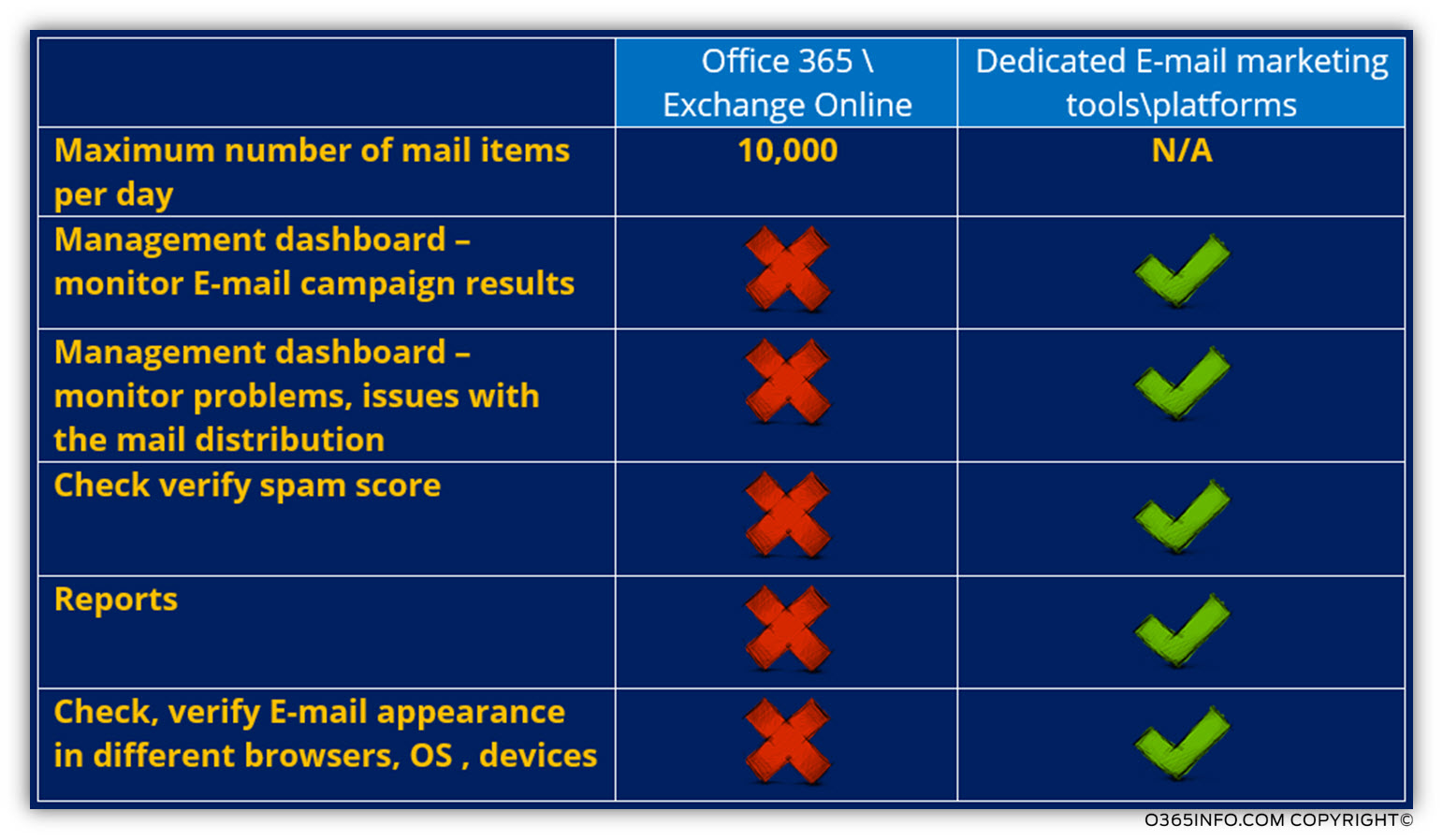
1. Maximum number of mail items per day
One of the most basic requirements of a commercial E-mail infrastructure is – to be able to provide the ability to send bulk mail to a large number of mail recipients.
Exchange Online include built-in limitation of maximum 10,000 mail items per user per day.
In case that you need to send commercial E-mail to a larger number of recipients, you want to be able to use Exchange Online.
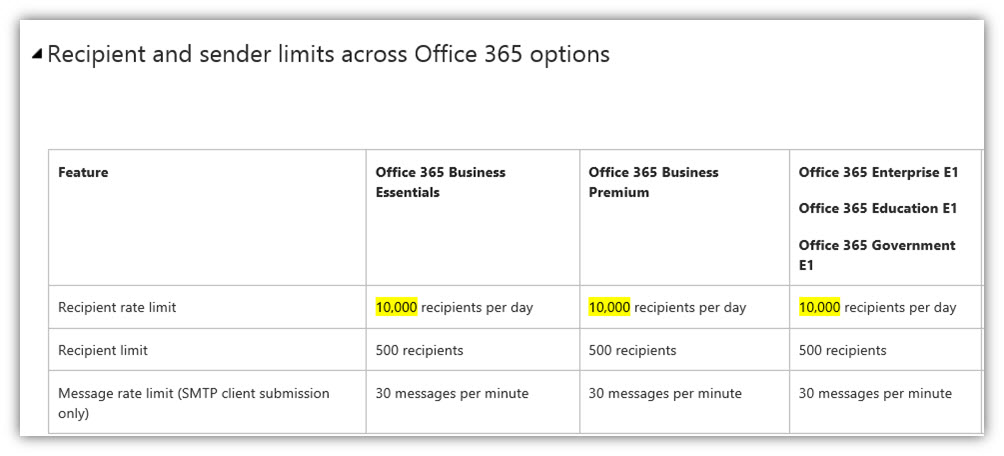
2. Management dashboard – monitor E-mail campaign results
One of the most basic requirements of an E-mail campaign is – the ability to get information about the status and the progression of the E-mail campaign. For example: how many E-mail sent, how many E-mail was “opened”(read) by the destination recipient, did the recipient click on a link attached to the E-mail, etc.
Exchange Online doesn’t include such abilities.
3. Management dashboard – monitor problems, issues with the mail distribution
The process of “distributing the E-mail” could be “accompanied’ by difficulties and problems such as a scenario in which the mail server IP address or our domain classified as spam, a classification of our mail server is “bulk mail server” and so on.
Some of the dedicated commercial E-mail infrastructures have systems and tools that could monitor the E-mail campaign, Identify and pre-alert about the possibility for problems or existing problems, etc.
Exchange Online doesn’t include such abilities.
4. Check and verify the spam score.
One of the most important procedures that need to implement before starting an E-mail campaign is: to make sure that our E-mail content will not have any charter, which will lead to a scenario in which our E-mail message could identify as spam/junk mail.
The solution to this need implemented by tools that enable us to evaluate the spam score of our E-mail message and allow us to pre-identified “area of problems” that lead to high spam score.
Most of the commercial E-mail infrastructure has built-in tools for this task. The bottom line: it’s crucial to verify the spam score of your E-mail campaign before you execute the E-mail campaign.
Exchange Online doesn’t include such abilities.
You can read more information about this procedure of assess the spam score level in the article: My E-mail appears as spam | The 7 major reasons | Part 5#17
5. Reports
The ability to display and export the information about E-mail campaign results or, capacity to implement BI (business intelligence) from the E-mail campaign results.
For example – the ability to “see” that our E-mail campaign results were good in a particular geographical location vs. other geographic locations.
Exchange Online doesn’t include such abilities.
6. Verify the E-mail “appearance” in different browsers, OS, devices.
The need to test our E-mail message “readability” on different infrastructures and devices.
For example – avoid a scenario in which our E-mail message has some presentation problem when using a browser such as Chrome or Internet Explorer.
Another example could be – a scenario in which our E-mail message has a presentation issue when using a mobile device.
Exchange Online doesn’t include such abilities.
Is there any “logic troubleshooting path” to implement in an Office 365 environment?
A detailed troubleshooting path in a scenario in which mail that is sent from our organization is identified as spam/junk mail will be provided in the articles:
- My E-mail appears as spam – Troubleshooting path | Part 11#17
- My E-mail appears as spam – Troubleshooting path | Part 12#17
In case that you want the “essence of the troubleshooting process” of internal spam in Office 365 environment, the answer is:
In scenarios in which E-mail that sent from our organization is identified as spam, most of the time, the major cause is: sending out commercial E-mail or if we want to be more precise: miss-use of commercial E-mail.
Many times, the implementation of a commercial E-mail not created by following the strict and well-known rules.
This “conclusion” is not a result of depth study about the: specific causes which lead to a scenario in which our organization E-mail identified as spam/junk mail but instead, my opinion.
From my experience, in Office 365 and Exchange Online environment, the main “event” that leads to a scenario in which our organization (our domain name or the Exchange Online server IP address) will appear on a blacklist is related to a commercial E-mail.
In simple words: an organization that uses commercial E-mail (marketing E-mail, newsletter, etc.) and, violate one or more of the “don’t do” rules of commercial E-mail.
In case that you are sure that the particular scenario is not related to a commercial E-mail, the next reasonable options are some malware that uses the “identity” of your organization to send spam/junk mail or “other” reasons.
The “other reasons” section can include any “other” reasons that can cause the “spam/junk mail” problem.
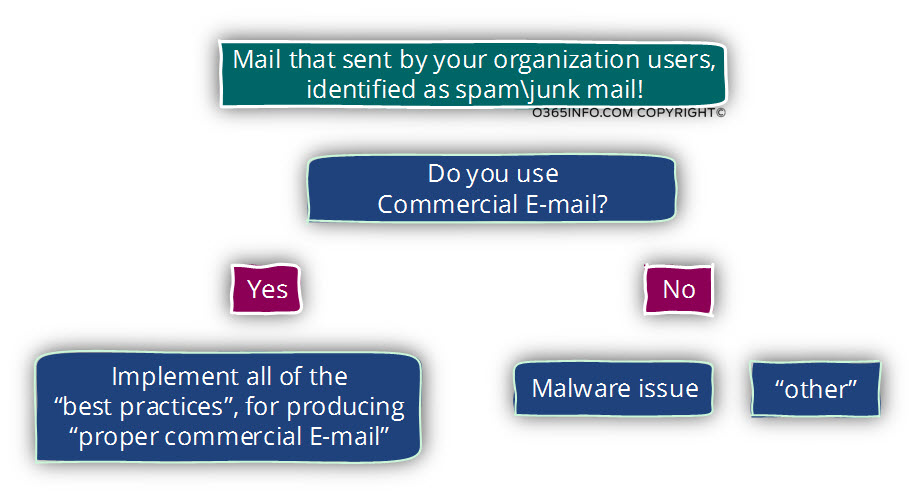
You can read more information about the optional causes for internal/outbound spam in the articles:
- My E-mail appears as spam | The 7 major reasons | Part 5#17
- My E-mail appears as spam | The 7 major reasons | Part 6#17
My point: when we deal with a problem in which our organization is classified as “element” to send spam/junk mail, don’t start the troubleshooting process by looking for the “guilty” outside of your house (Microsoft, conspiracy theory, extraterrestrial, etc.) but instead, thoroughly examined your organization E-mail “behavior”, the type of the E-mail message that your users send, problematic patterns and so on.


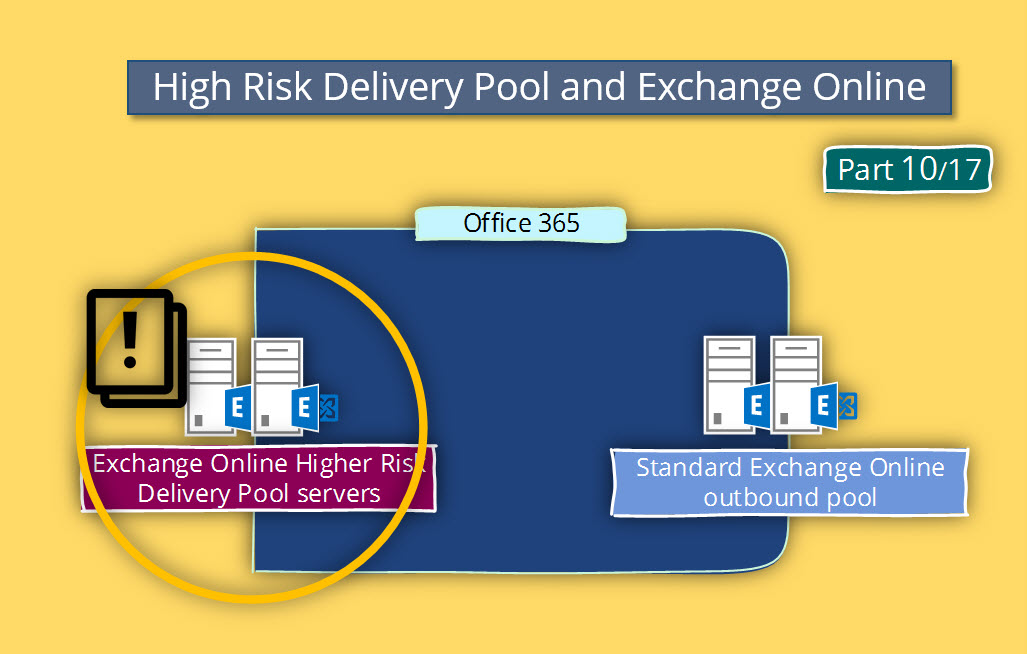
This Post Has 0 Comments